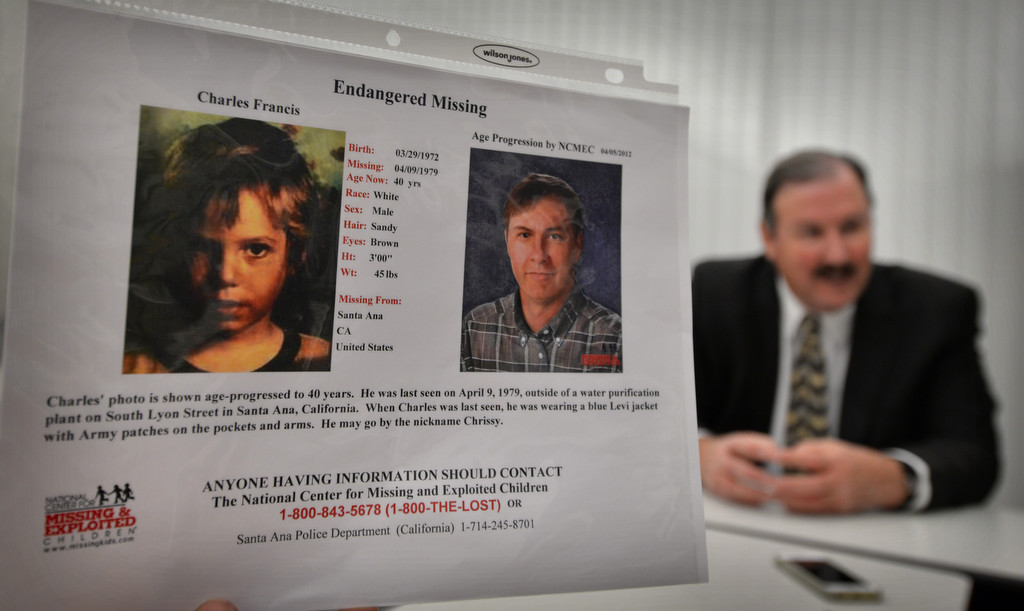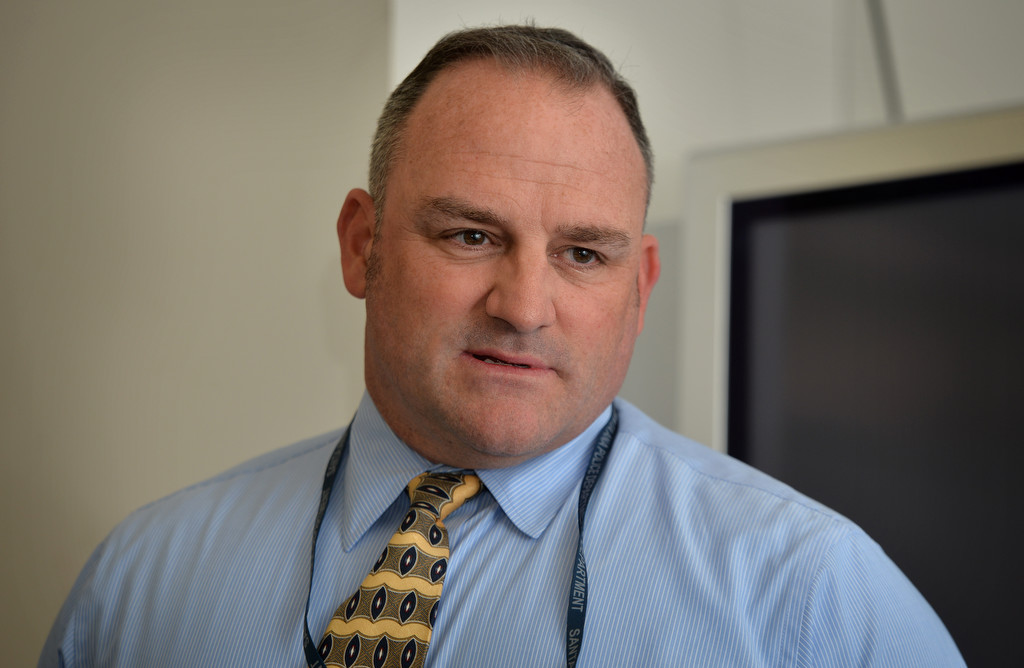The man staring back at the detective looks to be the same age as the little boy who disappeared off a Santa Ana street corner nearly 40 years ago.
The man and the little boy share a name.
And the man lives in the same area the missing little boy lived in before moving to California.
The detective in Colorado holds up a photo of the boy with sandy blonde hair and blue eyes.
Next to the photo is a composite sketch of what that missing boy would look like today at 42 years old.
The resemblance is striking.
“Is this you?” the Colorado detective asks the man.
“I don’t think so,” the man says.
Back in Orange County, Huntington Beach investigator Don Howell hears the news and is hopeful.
“This is him, we found him,” Howell said of the little boy he’s been trying to find since he joined the newly formed Orange County Homicide Task Force six months ago.
The man staring back at the detective is not sure, so they take a DNA sample.
And Howell waits.
***

Detective Don Howell with the Huntington Beach Police Department’s Crimes Against Persons Unit, currently on loan to the Orange County Homicide Task Force, talks about his work to help solve cold cases, including the case of Charles Christopher Francis who was 7 years old when he went missing in Santa Ana in 1979. The composite photo on the right is what he might look like if he is still alive today.
Photo by Steven Georges/Behind the Badge OC
On the same day in 2003 that Howell retired as a Huntington Beach detective after 24 years with the department, he was sworn-in as a part-time detective.
In mid-September, Howell was tapped by Huntington Beach to participate in a new team formed by the Orange County District Attorney’s Office to tackle an estimated 1,000 cold cases in Orange County.
Howell’s speciality is sexually-motivated crimes — a career path that has made for some awkward conversations in social settings over the years.
“You go to a party and someone asks, ‘Oh what do you do?’” he said. “I say, ‘Well, I’m an expert in child abuse-related homicide and child molest.’
“Now there’s a conversation starter. Most people are thinking, ‘Where’s the guacamole? We’re out of here.’
“It has its downsides, you know, but I find it absolutely fascinating.”
Those in law enforcement know his expertise is unmatched, and his skill will be called upon to solve what previously seemed unsolvable.
Every investigator on the task force has a speciality whether its gangs, narcotics, sex crimes or some other area of expertise.
Many are retired detectives who came back for a part-time gig, which means decades upon decades of experience to throw at these cases.
“Being able to tap in to their years of knowledge is very beneficial because they have great expertise,” said Santa Ana police Sgt. Richard Gatto. “These cases take a collaborative effort.”
The team, formed in August, has reviewed 125 cases so far and ranked 18 of them as having a high possibility of being solved.
Some of the cases don’t show the same promise, but the task force is reviewing them all.
“The one thing we absolutely want to make sure of is that we can tell all of these family members that we reviewed all of the cases equally,” Gatto said.

Detective Sgt. Richard Gatto of the Santa Ana PD working with the Orange County Homicide Task Force on cold cases.
Photo by Steven Georges/Behind the Badge OC
Task force members include investigators from Santa Ana, the DA’s office, the Orange County Sheriff’s Department, Huntington Beach, Anaheim, Fullerton and Garden Grove. The Santa Ana Police Department serves as headquarters for the task force.
Cases they are reviewing span from 1964 to 2010.
Howell brought three unsolved cases over from Huntington Beach, but is also assigned to cases from other agencies like the little boy who disappeared from the Santa Ana corner nearly 40 years ago.
***
Charles Christopher Francis’ parents were in a custody dispute.
The 7-year-old, who his family called Chris, lived with his father in Colorado Springs for most of his life, but his mother had legal custody.
Dennis Francis came out to Orange County three weeks before a custody hearing scheduled for April 26, 1979.
He started working as a water tank delivery man.
On an April afternoon that was characteristically sunny and temperate, Dennis Francis brought his son to work.
Bringing a child along to make deliveries was not allowed, so when it came time for Dennis Francis to return the truck, he told his son to wait out of sight.
Chris, wearing a Levi jacket with Army patches and blue pants, waited near a park on the corner of the 300 block of Lyon Street.
Ten minutes later, Dennis Francis returned and his son was gone.
April 9 will mark 36 years since Chris went missing.
He would be 43 on March 29.
***
Chris’ family said he was quiet and shy.
He was unlikely to talk to strangers and even more unlikely to get into a car with someone he didn’t know.
He was independent, though, and was probably comfortable waiting on that street corner.
Chris walked home from school every day in Colorado Springs, and it was more than a couple of blocks.
His parents said he wouldn’t have wandered off.
Police first suspected Chris was abducted by someone he knew, but investigators exhausted that possibility, Howell said.
When Howell took up the cold case in September, he re-interviewed everyone. Their stories didn’t change.
His work led him to Colorado where he asked a detective to visit a man named Charles Christopher Francis — the man who resembled the composite.
Howell waited at the Santa Ana Police Department for the DNA results to come back.
“Everyone is saying, ‘It’s going to be him, it’s going to be him,’” Howell said.
It wasn’t.
Howell realizes his theory is possibly true.
***
Ten days after Chris’ disappearance, a 13-year-old boy in Costa Mesa was kidnapped by serial killer and child molester, James Crummel.
James Trotter was walking to school when he was snatched by Crummel, who lived less than a mile away from the teen.
Eleven years later, the killer called police to report finding charred remains off Ortega Highway.
At first, investigators thought the remains were female, but dental records confirmed they were James Trotter.
Crummel was convicted in 1997 of murdering the teen.
It wasn’t his first murder conviction.
He was convicted in the 1967 murder of a 9-year-old boy in Arizona, but after serving just five years, the decision was overturned by a judge on a technicality.
Crummel was also suspected in the disappearance of a 9-year-old boy from Big Bear City and the 1981 murder of a 6-year-old Anaheim Hills boy.
Howell’s insight into the twisted inner-workings of a child molester and murderer tells him Chris may also be a Crummel victim.

Detective Don Howell specializes in child abuse-related homicide and child molest. He has written two books on how to interview sex crime suspects.
Photo by Steven Georges/Behind the Badge OC
Howell, who has written two books on sex crimes and is working on a third, said sex offenders’ impulses are triggered when their brain chemistry is off-balance.
He calls it a teeter-totter.
When the teeter-totter is level, a sex offender achieves some normalcy. If it starts to tilt, the sex offender will look to rebalance by controlling or dominating somebody else, Howell said.
“That’s what would happen with Crummel — he’d go out of balance, then offend, then go back to whatever normal was for him,” Howell said. “Crummel has a long history of kidnapping, molesting and murdering children.
“If he was out of whack on April 19, could he have been out of whack 10 days earlier?”
The possibility that Crummel kidnapped Chris was looked at before, but Howell said he’s revisiting it and sifting through every detail to find, or rule out, any connection.
Currently, he is trying to track down Crummel’s photographs.
The killer photographed children as a hobby — some of whom he molested or killed, and other random victims of his perverted fantasies.
“You have to look at everything again,” he said.
Although he knows if he finds the link to Crummel it likely means Chris will never be found, Howell will not speak in absolutes until he solves the case.
“You never know,” Howell said. “There’s always hope.”
 Behind the Badge
Behind the Badge



